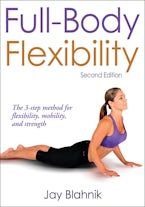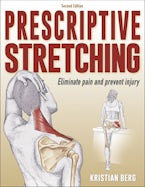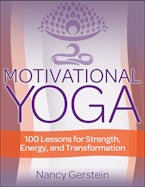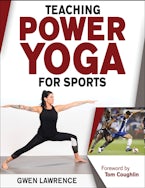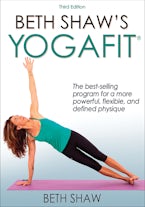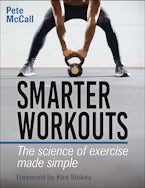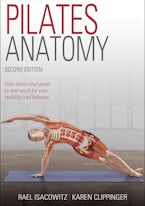
Combine mental focus and movement of the body
Balancing your workouts
Michelle Maloney, Human Kinetics Senior Acquisitions Editor, discusses:
- How to balance your workouts to address all areas of fitness
- What activities you can use to develop each facet of fitness and resources you can use
- Examples of what a balanced 1-week workout schedule looks like
Examples of sample workouts:
20 minute de-stress yoga flow
Open your twisted energy channels and de-stress with this quick 20-minute all-levels flow from Nancy Gerstein, author of Motivational Yoga.
Stretch away back pain
Prescriptive Stretching offers ready-to-use stretching sequences to target specific problems such as back or neck pain, runner’s knee, tennis elbow, stiff shoulders, and more.
Plantar fasciitis relief
If you struggle with the pain of plantar fasciitis or foot cramps, follow Gwen Lawrence’s instructions for this yoga move every morning for sweet relief.

13 exercises to help treat non-specific low back pain
More than 80 percent of people will experience low back pain at some point in their lifetime. This post, adapted from Brian Richey’s Back Exercise: Stabilize, Mobilize and Reduce Pain explores what non-specific low back pain is, what causes it and the exercises you can perform to treat it.
What is non-specific low back pain?
Non-specific low back pain is defined as low back pain that is not attributable to a recognisable, known specific pathology (e.g. infection, tumor, osteoporosis, lumbar spine fracture, structural deformity, inflammatory disorder, radicular syndrome, or cauda equina syndrome). In other words, there’s no specific source causing the pain – it could be caused by a number of different factors.

7 Pilates Exercises for Lower Back Pain to Help Relieve Tension
Several research studies have suggested that Pilates can be effective for relieving lower back pain. The benefits of doing Pilates include improved core strength, increased muscle strength and flexibility and improved posture. It’s also been found to be good for helping to manage pain. This article features a number of Pilates exercises for lower back pain taken from Pilates for Rehabilitation.
Strong and flexible back and shoulders – yoga sequence
Let Gwen Lawrence, author of Teaching Power Yoga for Sports, show you how to stretch and strengthen your back and shoulders through yoga.
L-Shaped Handstand for Shoulder, Arm, and Core Strength
Use the wall as support while you get used to being upside down (which can be scary), and gradually build up strength in the upper body. Learning to trust your upper body strength will happen gradually, so have fun with these poses and appreciate the wall as a friend!

Getting Into the Pose
From downward-facing dog with your heels pressed against a sturdy wall (figure a), activate your core and begin to walk slowly up the wall until your feet reach hip level. Press the feet firmly into the wall, and activate pada bandha. The hands should be stacked directly under the shoulders with the fingers spread wide (starfish hands; figure b). If you find your hands in front of the shoulders, walk the feet down and reposition them closer to the wall.
Holding the Pose
Press your fingers firmly into the mat, and press the feet into the wall for a fully active core. Draw the energy from the arms and the legs to the center of the body (figure c). For more sensation lift one leg off the wall, and reach the heel toward the sky. Switch sides. Concentrate on a slow, steady breath. Follow with child’s pose.
Modifications
If you need to minimize pressure on the wrists, then try forearm balance instead. If your feet slide down the wall, then concentrate more on core activation by drawing the muscles of the pelvic floor up toward the heart.
Turkish Twist Pose for upper back and oblique abdominals
This mountain III pose offers all the benefits of rotation combined with a deep hip stretch.

Getting Into the Pose
Cross one knee over the other. Draw your feet back toward your hips. First, sit tall (figure a) and relax into the hip stretch by drawing your forehead toward your knee on the exhalation (figure b). Use the sinking breath technique (chapter 3) to help release tension. Then sit tall, and place your hands over your chest in prayer position. Rotate toward your top leg, placing your elbow on your thigh (figure c).
Holding the Pose
Inhale to lengthen; exhale to rotate. Hold for 5 to 10 breaths. Switch sides.
Modifications
If one hip lifts off the floor, sit on a rolled-up yoga mat or folded blanket. If you have knee pain or difficultly stacking your knees, do a seated spinal twist instead.
Boat Pose for core strength and balance
Use boat pose in mountain III to strengthen your core and improve your balance. Practice boat pose after seated forward fold to assist you in maintaining a neutral spine by lengthening your back and hamstrings.

Getting Into the Pose
Sitting tall on the floor, bend your knees and hold on to your hamstrings. Slowly lift one foot at a time away from the floor, keeping your back long. Reach forward with your arms as you balance on your sit bones (ischial tuberosities; figure a). For a greater challenge, straighten your legs and reach forward without rounding your back (figure b).
Holding the Pose
Focus on your breath to lengthen your spine and lift your chest, relaxing your shoulders back and down (figure c).
Modification
If you’re a beginner or if you have back injuries, keep your feet on the floor and continue holding on to your hamstrings.
Side exercises for an effective core
From fundamental to intermediate to advanced, learning coordinated movement of the obliques and spinal extensors can increase strength and potentially prevent injury.


Stability ball exercises for mobility
Mobility exercises with fitness equipment can provide more leverage to take a limb through a greater ROM while also increasing muscle fiber activation to help improve muscle contraction patterns. The stability ball creates two unique challenges for the body: 1) The unstable nature of the ball can cause muscle contraction, which is an important part of mobility training. As one set of muscles contract to maintain stability, the muscles on the other side of the joint will have to lengthen to allow the muscles to contract. 2) The shape of the ball creates a unique lever that can help move the body into positions that lengthen muscle and connective tissue while enhancing joint motion. For best results, use a fully inflated stability ball, as this will create the instability for enhanced muscle activation while providing a stiff surface to optimize leverage into a joint position. Once you reach 20 reps per each side, work up to doing 4 sets of each exercise; for the stretches, keep the length of time the same, but feel free to add additional sets.
When selecting a stability ball, use a 55-centimeter ball if you’re 5′ 7″ or shorter. Select a 65-centimeter ball if you’re between 5′ 7″ and 6′ 4″. Select a 75-centimeter ball if you’re taller than 6′ 4″. The ball should be inflated until it’s firm and you can sit on it so your knees and hips can comfortably hold a 90-degree bend.
Foam rolling the posterior hip


Begin by placing the foam roller on a flat surface, and sit with one glute centered on the roller. Next, place at least one hand behind you for support while your feet are outstretched. Shift your weight to one side, with the body slightly rotated so more pressure is applied to one hip. Bend the leg you are not rolling so the foot is flat on the ground. The side that is being rolled can either be outstretched, or it can be crossed over the top of the other. I encourage you to try both positions to see which you prefer. Roll by slowly moving yourself downward so the roller moves up the glute at 1 inch, or 2.5 centimeters, per second (see figure 7.2a). If you find a tender spot, stop and hold for about 30 seconds. When the time is up, roll back through the muscle about four times; then, perform four to five hip flexion motions by raising the leg off the ground (see figure 7.2b).

24 Pregnancy Yoga Poses For A Strong, Healthy & Safe Pregnancy
This article advises on scientifically proven, safe and effective pregnancy yoga poses. These poses will make you feel better and aid delivery and recovery.
This article is adapted from Your Strong, Sexy Pregnancy by Desi Bartlett. Desi has worked with numerous celebrities, such as Kate Hudson during her pregnancy.
Within the article, we’ve picked out 24 yoga poses, stretches and sequences which will help you connect with your child and ensure you have a safe and healthy pregnancy.

At-the-office routine
This routine can be done easily and quickly at the office at your desk. All the stretches can be done from a standing or seated position. The routine is short but helps reduce back pain and energize your spine.
Chair Yoga
Whether or not you’ve recently had a baby, this yoga sequence from Desi Bartlett, author of Your Strong, Sexy Pregnancy, will make you feel strong and energized.

Health consequences of prolonged sitting
Lack of gravity or reduction of the influence of gravity (unloading with ineffective activity, reduced cardiovascular need for work, and lack of postural change signals) more than likely affects all physiological systems, with broad consequences. What was seen in space, Head Down Bed Rest (HDBR), and as we age has also been seen (or should be expected to be seen) from sitting as well. These changes are generally characterized by the rapid onset of an overall metabolic disorder characterized by loss of blood volume and red cell mass, fluid and electrolyte shifts, and a reduction in endothelium lining affecting the integrity of blood vessels, bone, and other systems that depend on the nitric oxide (NO) generated by shear forces, which are seriously reduced in Gravity Deprivation Syndrome (GDS). Central among these metabolic changes are insulin resistance, hyperlipidemia, decreased fat oxidation, a shift in substrate use toward glucose, reduced protein synthesis, loss of collagen, muscle atrophy with a shift in muscle-fiber type from slow to fast, ectopic fat storage with fatty infiltration of the liver and bone marrow with a consequent form of anemia, and reduced anabolic neuroendocrine secretions such as growth hormone, testosterone, and leptin. Rapid bone loss with possible ectopic calcium deposits round off the metabolic picture. Reduced sensitivity of sensory systems and reflexes, with decreased sensitivity of central and peripheral balance and coordination systems, is a prime feature of reduced gravity consequences as well. In addition, viral reactivation, immune deficiency with resistance to antibiotics, inflammation, and a reduction in telomere length and telomerase activity have all been observed.



